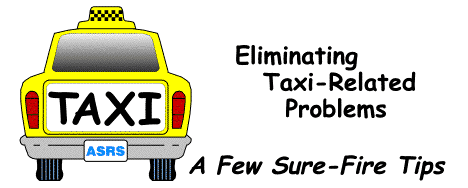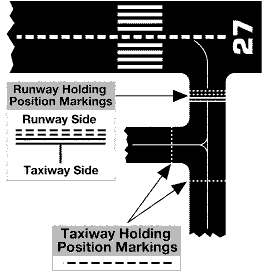![]()
Issue Number 3 : July 1992
|
|
Issue Number 3 : July 1992 |

by Robert Sumwalt
Even something as routine as taxiing poses its own set of potential safety-related problems. They aren't just limited to dented wing tips and excursions through the grass, either. Some taxi-related problems are quite serious. Of the seventy-five ASRS taxi reports reviewed by this author, most involved unauthorized runway transgressions. In this article we hope to offer a few practical suggestions towards eliminating future taxi-related problems.
Runway transgressions can be deadly. In fact, the worst accident in aviation history occurred due to a runway transgression at Tenerife, Canary Islands. Five hundred and eighty-three souls perished in that 1977 accident.
Fortunately not all runway transgressions involve accidents, but the potential for a catastrophe accompanies each and every one of them. While a national effort is underway to reduce runway transgressions, FAA figures reveal that the percentage of pilot-caused runway transgressions has increased since 1988. According to the FAA's Office of Safety Analysis, of the two hundred twenty-four runway transgressions reported in 1991, forty-one percent were pilot-caused. What can be done as an operator or flight crew to decrease the threat of runway transgressions?
ASRS reports reveal that some precautions can be taken before leaving the ramp. For instance, several runway transgressions in this data set occurred because crews became disoriented while taxiing. Several others reported that the lack of conspicuous taxiway markings and signs contributed to a runway transgression. No doubt these problems could be minimized if crews would place the airport diagram chart where it could be easily referred to during taxi. Reported one pilot:
And in another incident, an air carrier First Officer stated:
To be really effective the airport diagram should be located where it can be referenced without looking away from the taxiway. Some aircraft are equipped with chart holder "clipboards" on the side window frames. This is an ideal place to put the airport diagram. For aircraft that aren't so equipped, a piece of masking tape in the window frame works fine.
A few ASRS reports indicate that a runway transgression occurred because the Captain did not hear the clearance to hold short of a particular runway or taxiway. Reported one Captain:
There are several reasons why the Captain may not hear or comprehend "hold short" clearances. These include distractions, blocked radio transmissions, a mindset to taxi to a particular runway when another runway may be in use, and rushing. One noted problem is that sometimes the First Officer calls for the taxi clearance while the Captain is still off-frequency talking to the pushback crew on the interphone. One ASRS report revealed:
Here are a few suggestions that can help combat these traps. First, the initial call to Ground Control or Ramp Control for taxi clearance should not be initiated until the Captain and First Officer are both monitoring that frequency. This ensures redundancy while critical taxi instructions are being issued.
Next, whenever a "hold short" clearance is issued, the Captain and First Officer should repeat the hold short clearance to each other. If a pilot fails to verbalize the clearance, the other pilot must then challenge him/her to be sure that the clearance was understood.
Finally, it's suggested that the First Officer write down the taxi clearance and holding instructions.
Several pilots complained that cockpit distractions contributed to their runway transgression. Examples include distractions caused by completing checklists, obtaining weight and balance information, and loading flight management computers. ASRS narratives include statements such as:
Another air carrier pilot reported that he became distracted when a Flight Attendant entered the cockpit to give the passenger count.
Air carriers are urged to review their policies and procedures to look for and eliminate practices that could contribute to taxi distractions. Paraphrasing FAR 121.542:
"No certificate holder shall require, nor may any flight crewmember perform, any duties during a critical phase of flight except those duties required for the safe operation of the aircraft.... Critical phase of flight includes all ground operations involving taxi...."
Can weight and balance information be delivered at the gate instead of during taxi-out? Can checklists be rewritten to minimize distractions during taxi-out? And is it really necessary to require pilots to call station operations to report "on the ground" after landing? Reported one crew:
A few runway transgressions occurred when pilots were instructed to taxi on inactive runways. Because runway surfaces are designed for takeoffs and landings, they are not marked for taxiing. Therefore the usual cues such as holding lines for intersecting runways probably will not be present. Following a runway transgression one ASRS reporter offered:
Because of the lack of these markings pilots should be particularly alert when taxiing on runways.
 Sometimes
to resolve complex problems it may be necessary to go back to basics. And as
basic as it may seem, a few ASRS reports indicate that some pilots have difficulty
distinguishing the "holding side" of runway holding lines from the
"non-holding side."
Sometimes
to resolve complex problems it may be necessary to go back to basics. And as
basic as it may seem, a few ASRS reports indicate that some pilots have difficulty
distinguishing the "holding side" of runway holding lines from the
"non-holding side."
Recall that holding lines lie perpendicular to the taxiway and consist of two continuous and two dashed lines, each spaced six inches apart.
According to the Airmen's Information Manual:
"When approaching the holding lines from the side with the continuous lines a pilot should not cross the holding line without ATC clearance at a controlled airport, or without making sure of adequate separation from other aircraft at uncontrolled airports."
ASRS reports also indicate that problems can arise when pilots turn off onto another runway after landing. Reports a Controller:
A pilot reported:
Another stated:
It's important to understand that the Airmen's Information Manual states that when clearing a runway after landing, pilots should not turn onto another runway without authorization from the tower. Perhaps a study of the airport diagram prior to landing would help here by increasing situational awareness.
A couple of ASRS reports illustrate hazards associated with beginning taxi without obtaining the "all clear" salute from the ground crew. A jump seat rider observed:
The reporter surmised:
Another crew reported that they struck a deicing truck after beginning a premature taxi. The reporter explains that rushing and "the lack of coordination between the cockpit and ground personnel" contributed to the incident. "After deicing [was] started and the [deicing] truck moved rearward no ground personnel were [visible to] the cockpit [crewmembers]. [This led] to the assumption by the Captain that deicing had been completed." Be careful with assumptions.
Although the act of taxiing an aircraft to and from an active runway may seem a little routine, ensuring that it is done safely requires planning, coordination, and attention. And more than just one set of eyeballs on a swivel is also necessary.
Let's review some of the things which can help flight crews make that taxi operation safer:
Any pilot knows the danger of a midair collision. But stop and consider this: the likelihood of a collision with another aircraft, vehicle, pedestrian, or other object while taxiing is about three times greater than the chance of striking another aircraft in flight. Now then, is taxiing as routine as you may have thought it was?
| Reproduction and redistribution of ASRS Directline articles is not only permitted--it is encouraged. We ask that you give attibution to ASRS Directline, to the Aviation Safety Reporting System (ASRS), and of course, to the authors of each article. |